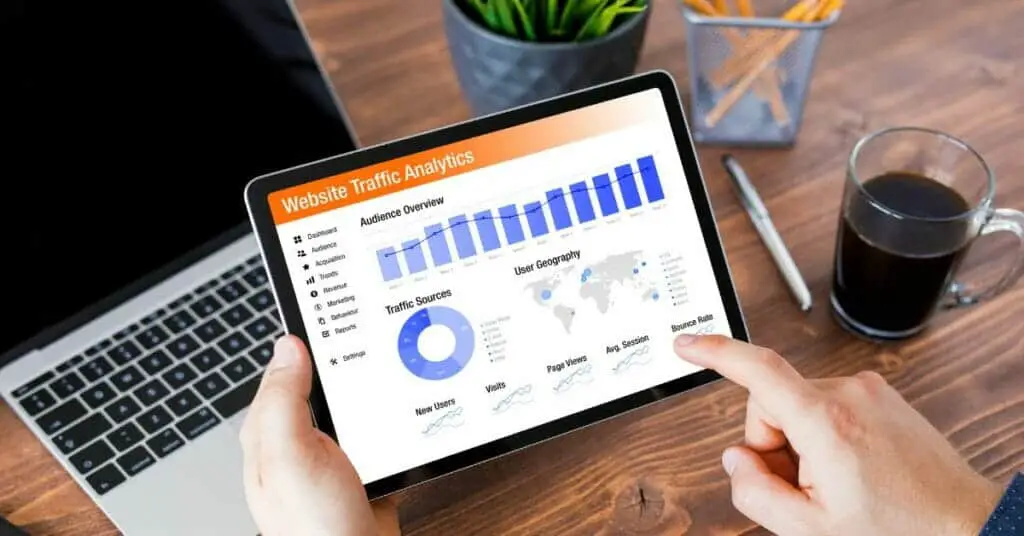What is Ecommerce Conversion Rate and why does it matter?
When you're running an online store, it's crucial to understand what your eCommerce conversion rate is and how to improve it. After all, if your business isn't making sales, it won't be very successful!
If you want to increase your revenue, it's important to focus on increasing your conversion rate. In this blog post, we'll discuss what is ecommerce conversion rate, why it matters, and how you can start improving yours today.
DISCLOSURE: Some of the links that I share in this article ARE my affiliate links. This means I may earn a commission, at no extra cost to you. In fact, sometimes you'll get a discount or free credits just FOR using my link. 🙂
What is eCommerce conversion rate?

A conversion occurs when a visitor to your website takes an action that you desire, such as signing up for a newsletter, making a purchase, or downloading a white paper. The percentage of website visitors who take this desired action is your eCommerce conversion rate.
How is eCommerce Conversion Rate Calculated?
This number can be determined by dividing the number of completed sales by the total number of visitors to your store. Several factors affect your store's eCommerce conversion rate, including the design of your website, the quality of your products, and your pricing.
eCommerce Conversion rate = (conversion/total visitors) * 100
There are three main types of conversion rates: gross, net, and total. The gross conversion rate is the number of visitors who make a purchase, including those who did not buy immediately.
The net conversion rate is the number of visitors who make a purchase, excluding those who did not buy immediately. The total conversion rate is the sum of direct, indirect, and gross conversion rates.
A high conversion rate means that more people are interested in what you're selling and are buying from you, which is good for business. A low conversion rate shows that there's room for improvement.
Conversion rate optimization can improve store efficiency and marketing efforts. By evaluating your store's conversion rate, you can find areas for improvement to boost sales.
What are the key components of eCommerce conversion rate?
After answering the question, what is eCommerce conversion rate, let's look at its key components. From the equation above, you can see that there are several key components to a store's conversion rate.
The first is the number of total visitors, and the second is the number of visitors who make a purchase. The third is the percentage of visitors who purchase compared to the total number of visitors.
It makes sense to concentrate on raising your conversion rate because after spending money to bring traffic to your website, customers are already at your store and can be converted into buyers. Therefore, the higher your conversion rate, the more sales you will be making.
Why is eCommerce conversion rate important?

This number is important because it tells you how effective your website is at converting visitors into customers or how successful your website is at achieving its goals. If you want to increase your sales, then you need to focus on improving your conversion rate.
Tracking conversion rates allows store owners to put their sales performance into perspective and make data-driven decisions about their business. Store conversion rate is important for retailers because it helps them set goals, track the effectiveness of marketing campaigns, and determine staffing needs.
What are the benefits of increasing your eCommerce Conversion Rate?
Some benefits of increasing your eCommerce conversion rate include:
– Increased Revenue: Improving the conversion rate of your store is a very cost-efficient way to increase sales as it does not need more marketing or sacrificing profits.
-Increased Efficiency: Conversion rate optimization can improve store efficiency and marketing efforts. Discounts can be given away without sacrificing margins, and marketing spending can be reduced without reducing the quality of products or services.
– Identify Areas for Improvement: By understanding your store's conversion rate, you can identify areas where improvements can be made to increase sales.
What is considered Good Ecommerce Conversion Rate?
Your eCommerce store conversion rate will vary depending on what you're selling and your target market. However, a good eCommerce conversion rate is typically anywhere from 3% to 5%.
If your conversion rate is below 3%, then you need to make some changes to your website to increase traffic and improve customer engagement. If your conversion rate is above 5%, then you're doing well and should focus on maintaining this level of success.
How can you increase your Ecommerce Conversion Rate?
There are several things you can do to increase your conversion rate and they are listed below:

By optimizing your website for search engines
Search engine optimization (SEO) is the practice of improving the visibility of a website or web page in search engine results pages (SERPs). By making a website or web page more visible in search engine results pages, SEO can help boost eCommerce conversion rates.
Make sure your website is fast and responsive
A slow website will frustrate visitors and cause them to leave without making a purchase. Use Google's PageSpeed Insights tool to test the speed of your website and get recommendations for improving its performance.
One way to improve your conversion rate is to optimize your website for mobile devices. This means that your website is easy to navigate and looks good on smaller screens.
Google's mobile testing tool can help you determine if your site is mobile-friendly. If it's not, then you need to make some changes to improve the user experience for mobile visitors.
By improving the user experience on your website
You can create a personalized experience for your customers that keeps them focused on your desired action across platforms. By doing this, you shorten the path to purchase and increase your chances of converting visitors into customers.
Make sure your website is easy to navigate
An easy-to-navigate website will help visitors find what they're looking for quickly and without frustration. Use clear and concise labeling, well-organized menus, and search functionality to help visitors find what they need.
Use high-quality images and videos
Including product images and videos that are eye-catching can help increase customer engagement. High-quality images and videos can help improve the visual appeal of your website and product pages.
Use professional-looking photos and videos that showcase your products or services in the best light.
Make sure your website is secure
A secure website will give visitors confidence that their personal, and financial information is safe. Make sure your website has an SSL certificate and that all payment information is encrypted.
By providing great customer service
Customer service is important for maintaining relationships with your customers and increasing customer loyalty. Offer excellent customer service by promptly responding to customer inquiries, providing helpful information, and resolving any problems quickly.
Including live chat support on your website can help create a sense of urgency and increase customer engagement.
By offering discounts, coupons, or free shipping
Offering discounts and coupons can help increase your store conversion rate by encouraging customers to buy from your store. Discounts and coupons can be offered in a variety of ways, such as through email marketing campaigns, social media posts, or on your website.
Rewards for customers who make a purchase also increase store conversion rates by providing an incentive for customers to complete a purchase.
Free shipping is another great way to encourage customers to buy from your store. By offering free shipping, you can remove one barrier to purchase and make it more likely that visitors will complete a purchase.
By providing customer reviews and testimonials
Your store's conversion rate may be raised by including reviews and testimonials from customers. Showing potential customers that others have had positive experiences with your business helps to establish trust and can make them more likely to convert into paying customers.
Offering incentives, such as a coupon code or other types of incentives the next time they purchase, can encourage customers to leave positive reviews. Product testimonials are also a valuable signal to shoppers and can help boost conversions.
By reverse engineering the customer’s journey
One of the best ways to improve your eCommerce conversion rate is to reverse engineer your customer’s journey. This means that you understand what steps customers take on their way to making a purchase and what can cause them to leave without making a purchase.
This can help you identify areas where you can improve customer experience or what changes you need to make to your website to increase conversion rates.
Finally, make sure that you have a strong call to action on every page of your website. This will encourage visitors to take the desired action, such as making a purchase.
By using effective marketing campaigns
You can also improve your conversion rate by using effective marketing campaigns, such as email marketing or social media marketing. By bringing more visitors to your site, you increase the chances that they will make a purchase.
By using these tips, you can increase your eCommerce conversion rate and start making more sales. Implementing even a few of these strategies can have a positive impact on your business.
Tools to help Increase Ecommerce Conversion Rates
You can use a variety of tools to help you reverse engineer your customer’s journey, such as heat mapping software, session recordings, or analytic data. I have listed three of them below:
HotJar
HotJar is a great tool for gaining a high-level knowledge of how users interact with your website. It provides an overview of where users click, move, and scroll on your site.
The heat mapping tool allows you to see where users are spending the most time on your site. This can help you understand user behavior patterns and identify areas of your site that need improvement.
Session recordings show you what a user does on your site. This can help you understand what is causing users to leave your site without making a purchase.
HotJar also offers additional data, such as real-time suggestion boxes, customized user surveys, and live user playback, that can help you learn how to interact with users and what services they are interested in. They can help improve customer engagement and conversion rates.
You can set up attribute-based filters based on visit length, page views, country, device, and more – individually or in combination.
Hotjar offers a freemium pricing plan, which allows users to track up to 1,050 sessions per month for free. Paid plans start at $32/month if you pay annually and allow users to track up to 3,000 sessions per month. Hotjar also offers custom pricing for larger organizations.

Quantcast Measure

Quantcast Measure is a tag-based analytics tool that provides deep insights into who visitors are on a personal level. This has translated into business intelligence for creative teams who can tailor messaging and imagery to resonate more deeply.
Quantcast Measure also offers a composition view – demographics as a percentage of the whole – which can be helpful in understanding which segments of visitors you're reaching disproportionately. You can compare your website's performance with other websites in your country or around the world.
Quantcast Measure can help improve eCommerce conversion rates by providing valuable insights into who your visitors are and how best to reach them.
Google Analytics

Google Analytics is a free web analytics tool that helps you track your website’s traffic and performance. It provides data on website activity and visitor behavior, thus offering insights into website traffic and behavior.
Google Analytics allows you to see how many visitors come to your website, what pages they visit, and how long they stay on your site. It can also give you information on how long visitors stay on your website, what browser or operating system they are using, and how many visitors converted.
This information can improve eCommerce conversion rates by understanding what content is being accessed, how users interact with it, and whether they make a purchase. You can use Google Analytics to measure the success of your marketing campaigns and see which strategies are working best for you.
By using Google Analytics to find out which elements of your website are causing people to leave or stay on your site longer than they intended to, you can then use Google Analytics data to improve the design of your website or improve the way it functions overall.
Google Analytics can also track paid traffic. By linking Google Analytics to an AdWords campaign, businesses can more accurately track the success of each ad campaign in terms of website traffic and conversions.
Tracking your eCommerce conversion rate
It is important to track your eCommerce conversion rate because it can help you understand what is causing people to make a purchase and what is causing them to leave your site without making a purchase. It's also important to track your conversion rate so you can see how effective your efforts are in increasing sales and make changes as needed.
By tracking your eCommerce conversion rate, you can improve your website’s design, content, and functionality to make it easier for people to buy. You can also use data from Google Analytics to improve your marketing campaigns and see which strategies are working best for you.
Conclusion
In conclusion, I shared what is ecommerce conversion rate, why it's important in this article. eCommerce conversion rate is a metric that helps business owners understand what elements of their website are causing people to make or not make a purchase. It can also track the effectiveness of marketing campaigns to increase sales.
It is important because it helps you understand what is causing people to purchase on your site and what is causing them to leave without making a purchase. I have gone through some tips that will help you increase your Ecommerce Conversion Rate and suggested some helpful tools.
If you have any questions or other tips on improving your eCommerce conversion rate, please leave a comment below!



![How Much Does it Cost to Start an Online Business? [Website & eCommerce]](https://ecommercewithpenny.com/wp-content/uploads/2022/09/how-much-does-it-cost-to-start-an-online-business-feature-image-1024x536.jpg)




